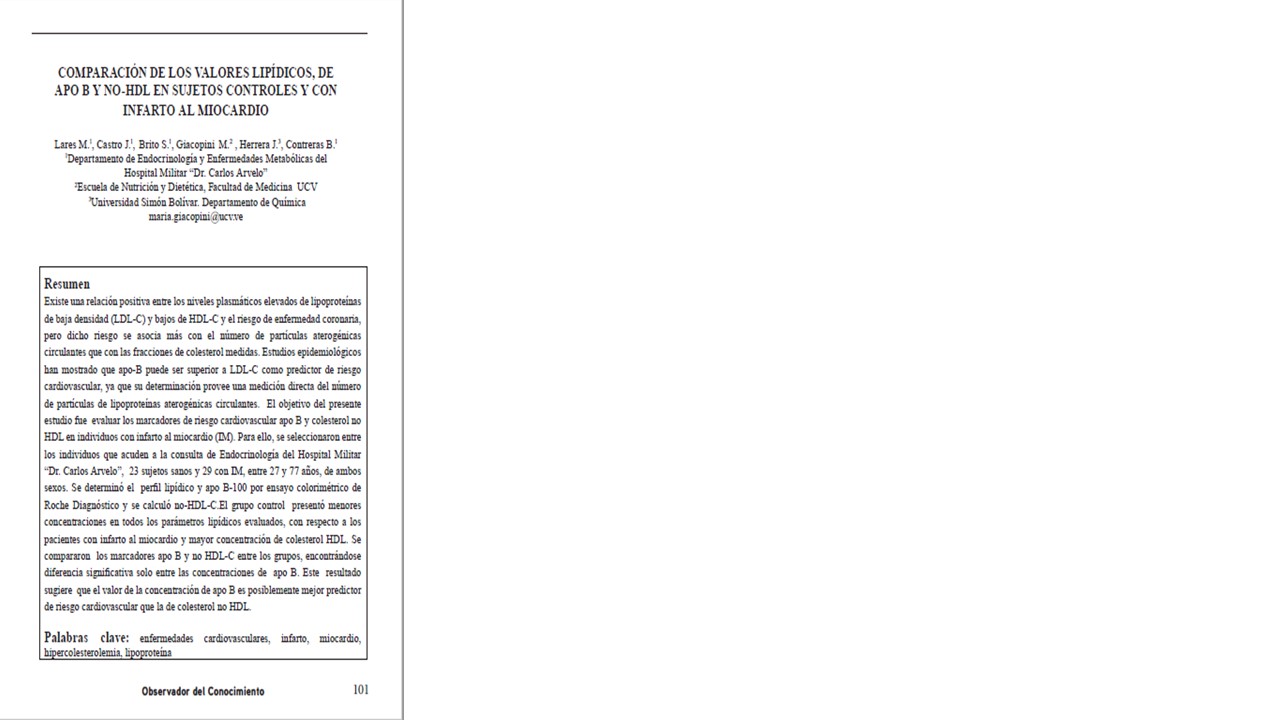Comparison of The Values Lipídicos, APO B and No-HDL Gives in Fastened Controls and With Heart Attack To The Myocardium
Keywords:
Cardiovascular diseases, heart attack, myocardium, hipercolesterolemia, lipoproteínaAbstract
The aim of the present study was evaluated the scoreboards of cardiovascular risk apo B and cholesterol not HDL in individuals with heart attack to the myocardium (IM).For it, they were selected between the individuals who come to the consultation of Endocrinology of the Military Hospital "Dr. Carlos Arvelo", 23 healthy subjects and 29 with IM, between 27 and 77 years, of both sexes.The profile decided lipídico and apo B-100 for Roche Diagnóstico's colorimetric test and group calculated not-HDL-C.El control presented minor concentrations in all the parameters lipídicos evaluated, with regard to the patients with heart attack to the myocardium and major concentration of cholesterol HDL.The scoreboards were compared apo B and not HDL-C between the groups, being significant difference alone between the concentrations of apo B.
Downloads
References
Austin, M.; Breslow, J.; Hennekens, C.; Buring, J.; Willett, W.; Krause, E. (1988). Low-density lipoprotein subclass patterns andrisk of myocardial infarction. JAMA 260:1917-1921.
Boissonnet, C.; Fusell, J.; Guetta, J.; Godia, J.; Tettamanzi, A.; Quiroga, S.; Torres, V. (2002). Niveles bajos de colesterol HDL como marcador independiente de riesgo alejado en síndrome coronarios agudos sin elevación del segmento ST. Revista Argentina Cardiología. 70: 6-17.
Castelli, W.; Garrison, R.; Wilson, P. (1986). Incidence of coronary heart disease and lipoprotein cholesterol levels. The Framingham Study. J. Am. Med. Assoc 256: 2835-2838.
Chan, D.; Watts, G. (2006). Apolipoproteins as markers and managers of coronary risk. Q. J. Med. 99:277–287.
Durrington, P.; Hunt, L.; Ishola, M.; Kane, J.; Stephens, W. (1986). Serum previous myocardial infarction. Br Heart J. 56 (3):206-12.
Genest, J.; Frohlich, J.; Fodor, G.; McPherson R. (2003). The Working Groupon Hypercholesterolemia and Other Dyslipidemias, Recommendations for the management of dyslipidemia and the prevention of cardiovascular disease. Update. CMAJ.169:921-924.
Grundy, SM. (2002). Low-Density Lipoprotein, Non-High-Density Lipoprotein, and Apolipoprotein B as Targets of Lipid- Lowering Therapy. Circulation. 106:2526–2529.
Kim, B.; Kwang, S.; Sung, K. (2005). Comparison of the relationships between serum apolipoprotein B and serum lipid distributions. Clin. Chem. 51:2257– 2263.
Ministerio del Poder Popular para la Salud de la República Bolivariana de Venezuela (2009). Anuario de Mortalidad 2007.Caracas, Venezuela.
Otvos, J.; Mora, S.; Shalaurova, I.; Greenland, P.; Mackey, R.; Goff, D. (2011). Clinical implications of discordance between low-density lipoprotein cholesterol and particle number. J. Clinical Lipidology. 5:105– 113.
Pintó, X.; Ros, E. (2000). Lípidos séricos y predicción del riesgo cardiovascular: importancia de los cocientes colesterol total/colesterol HDL y colesterol LDL/ colesterol HDL. Clin. Invest. Arterioscl. 12:267-284.
Sniderman, AD. (2002). How, when, and why to use apolipoprotein B in clinical practice. Am. J. Cardiology. 90 (S):48i– 54i.
Sniderman, AD.; Junger, I.; Holme, I.; Aastveit, A.; Walldius, G. (2006). Errors that result from using the apoB/apoA-I ratio to identify the lipoprotein-related risk of vascular disease. J. Intern. Med. 259:455-461.
Steimberg, D.; Witztum, JL. (1990). Lipoprotein and atherogenesis: current concepts. J. Am. Med. Assoc. 246: 3047- 3052.
Walldius. G.; Jungner, I.; Aastveit, A.; Holme, I.; Furberg, C.; Sniderman, A. (2004). The apoB/apoA-I ratio is better than the cholesterol ratios to estimate the balance between plasma proatherogenic and antiatherogenic lipoproteins and to predict coronary risk. Clinical Chemistry and Laboratory Medicine. 42:1355– 1363.

Downloads
Published
How to Cite
Issue
Section
License

This work is licensed under a Creative Commons Attribution-NoDerivatives 4.0 International License.







